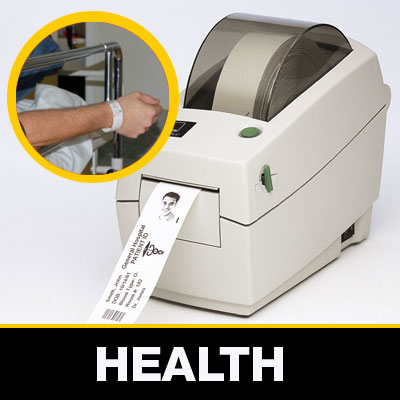Enjoy benefits and new preview !

Healthcare: Florance National Health Centre, Italy
Zebra® patient ID wristbands dramatically improve patient safety at Italian health authority.
The National Healthcare Centre 10 in Florence is the most important health authority in the city. It is spread across six different locations in Tuscany (Santa Maria Nuova, Nuovo Ospedale San Giovanni di Dio, Santa Maria Annunziata, Serristori, Nuovo Ospedale del Mugello) and the Istituto Ortopedico Toscano.
This Italian health authority has more than 1400 beds, along with over 7900 doctors, medical attendants, administrative and support staff who all treat 145,000 patients annually
The Challenge
The National Healthcare Centre 10 in Florence is dedicated to safeguarding patients during their treatment at any of its facilities. As a result the Florence authority, together with seven other healthcare centres in Tuscany (Careggi, Empoli, Grosseto and Siena) organised a patient identification campaign which was fully supported by the Regional Centre for Clinical Risk Management.
The Regional Centre for Clinical Risk Management is responsible for identifying key health service areas that need improving. 2.6% of laboratory errors stem from incorrect patient identification, while 67% of blood transfusion errors are linked to the using the wrong blood components. Key factors in accident and emergency (A&E) medicine are: unique patient characteristics (e.g. foreign patients with complicated names), time dependant medical procedures, a change of hospital staff during patients’ treatments and the completion of multiple cases during the same surgery session.
Key to all these errors was the inability to correctly identify the treatment. Therefore it was necessary to build and implement a technology solution that could guarantee correct patient identification as well as improve communication between medical staff.
The Solution
Run by Zebra’s Premier Partner in Florence, the project’s first phase focused on clarifying the best instruments for optimising patient identification. A survey was carried out to identify benefits and challanges to a range of solutions used in other hospitals including: the Gemelli Hospital in Rome, the Niguarda Hospital in Milan and the Manzoni Hospital in Lecco.
Following the research, Zebra Z-Band® Direct thermal wristbands and desktop thermal printers LP 2824-ZTM were the ideal solution. Key to this decision, and at the core of the evaluation criteria were: reliability, total cost of ownership, traceability of information, impact on the operator’s work and patient acceptability. The Zebra® wristbands met all these needs and were installed in the A&E ward of Nuovo Ospedale del Mugello in Borgo San Lorenzo. At this point, all patients admitted through the A&E ward receive an identification wristband with an information sheet explaining its use and its advantages. Each wristband contains personal data (full name, place and date of birth, gender, tax code) and health information (personal allergies, existing medication details or prior medical conditions - such as diabetes).
The wristband is a key tool in eradicating clinical errors. Key areas where the certainity of patient identity is critcial include: doctor’s examination, therapy prescription, drug administration, patient preparation for clinical tests and before blood transfusions. Furthermore, the wristband helps identify the patient when moving them to and from operating theatres, between different wards and for administration purposes.
The Benefits
During the 3-month trail, more than 68,000 wristbands were used. The trial’s results prove that patients are more than happy to use the wristbands which they understood to have safety benefits. Many were pleased to see the introduction of the wristbands. 90% of staff interviewed during the trial highlighted that the wristbands proved to be particularly valuable when patients were unable to identify themselves. The wristbands were seen to be especially useful when taking patients for diagnostic tests (43%), during therapy (37%) and prior to carrying out blood transfusions (33%).
Furthermore, thanks to Zebra® wristbands, research carried out alongside the trial has shown that using them has prevented 220 mistaken identity cases (62 incidences of mistaken identity when moving patients, 54 incidents of misdiagnoses, 50 cases of incorrect treatment being administered, 30 deliveries of the wrong blood type and 24 surgical errors). These products have almost certainly saved several lives and tens of thousands of Euros.
Future Implementations
The project’s main objective was best practice definition for correct patient identification, in addition to producing a comprehensive guide for the implementation of such technology across the health authority. The aim was to identify the benchmarks and the necessary conditions for a computerised management system, involving all the healthcare services in Tuscany.
“I’m one of the key supporters of this project at regional and national level and I’m extremely satisfied with the results of this trial,” said Dr. Francesco Venneri, head of Operative Emergency Surgery Wards and Clinical Risk manager of the National Healthcare Centre n.10 in Florence. “Thanks to their ease of use, Zebra® wristbands have been readily accepted by both patients and staff. In the future, when this technology is deployed across all hospital wards, it’s very likely that we will use barcode wristbands which can hold more information. Also thanks to the use of an electronic device they’re now able to improve patient safety even more.”
Register to the Newsletter
ZEBRA Technologies
First 100% Zebra online store
The myZebra site is the online sales platform from ECE,
a specialist of Zebra products.
ECE has no tied what so ever to Zebra Technologies Corporation.














